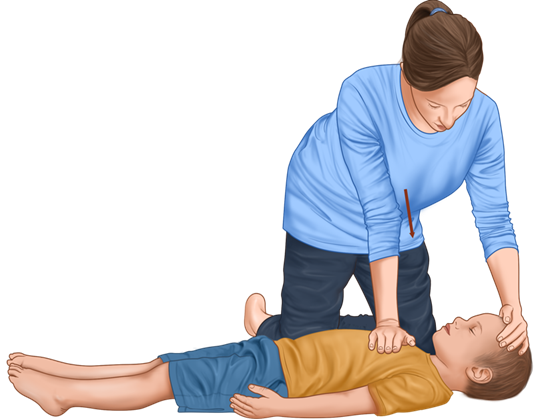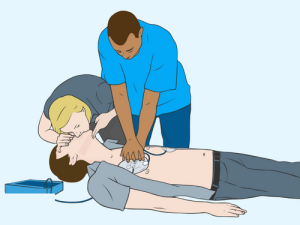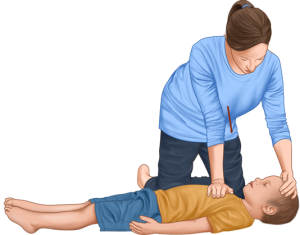Introduction
A prompt and efficient response can mean the difference between life and death in medical emergencies. In recent times, there have been avoidable deaths of different people especially celebrities because the knowledge of CPR and the technique were lacking in Africa.
At Wellahealth, we believe knowledge is power, especially when it comes to saving lives. This article will discuss the importance of CPR, its potential impact on African communities, and the steps people can take to learn this life-saving skill.
When someone’s breathing or heart stops, Cardiopulmonary Resuscitation (CPR) is a vital skill that enables people to act and save lives. Knowing CPR is especially important in Nigeria, where access to emergency medical care can be difficult in rural areas.
What is CPR and Why is it Important?
The heart is an essential human body pump that keeps the blood flowing throughout the body, carrying oxygen to every portion, oxygen and nutrients are essentials for organ and tissue survival. When blood flow stops for any reason, organs like the brain receive less oxygen rapidly and the heart stops beating (cardiac arrest (time-sensitive medical emergency)). Without oxygen, brain cells start to die within minutes, causing either irreversible damage or death.
Cardiopulmonary Resuscitation is a series of manual procedures that help maintain blood flow and oxygen delivery to the brain and other essential organs. It consists of chest compressions and, rescue breathing that buy individuals valuable time and greatly improve the chances of human survival.
CPR done by a bystander or onlooker can be the lifesaver that keeps someone alive until professional aid arrives in Africa, where there may not be as much infrastructure or funding available for emergency medical care. Knowing how to conduct CPR can dramatically increase the chances of survival in cardiac arrest cases, regardless of whether the incident occurs in a busy city centre or a secluded village.
Signs of Cardiac Arrest
Every individual must recognize cardiac arrest, there are a few signs a bystander should look out for cardiac arrest:
- Sudden collapse.
- No pulse: A quick 10-second look for a pulse in the neck or wrist fails.
- No breathing: When you put your cheek close to their mouth and you don’t feel any breath on it and there are no chest motions.
- Loss of consciousness: Shaking or yelling at the person does not cause them to wake up; they remain unconscious.
How to perform CPR
CPR can be performed for infants, children, and adults. Once the bystander confirms the victim is not breathing, here are a few steps to take to perform CPR whether you have been trained or not.
Credit: American Red Cross Society
Techniques for Doing CPR on an Adult
Credit: CPR select
Anybody who has reached puberty (often around the age of 12) and beyond is considered an adult in first aid terminology. Only qualified and trained first aiders should give rescue breaths as well as chest compressions, if you are not a trained first aider do only chest compressions. The following should be done when carrying out CPR on an adult:
- Verify that the emergency services (dial 112) have been contacted right away, this should be done by someone who isn’t going to be involved in CPR. However, if the bystander is alone they should communicate with the emergency services they conduct CPR by putting the emergency service (112) on speaker phone.
- Place the victim on their back and kneel close to them.
- Lean over the victim with your arms straight and the heel of one hand on their breastbone in the middle of their chest. Making sure your fingers don’t contact their ribs, place the heel of your second hand on top of your first.
- Maintaining a straight arm position, apply pressure directly downward to a depth of 5 to 6 cm (about 2.5 inches) using your body weight. Let go of the strain and permit the chest to expand once more. At a pace of two per second, about 100 to 120 forceful pushes per minute should be applied to the victim’s chest, repeat this thirty times.
- After 30 chest compressions, a trained first aider should give rescue breaths. For a bystander who lacks training, just keep performing chest compressions. In the intervals between compressions, let the chest expand fully. Continue repeating this until help arrives.
- If the victim starts to breathe normally, you should put them in the recovery position, their sides(a person is turned onto their side and their tongue falls forward, allowing the stomach’s contents to escape through gravity). Continue to monitor their condition while you wait for the emergency services to arrive as you may need to give CPR again.
Techniques for CPR on a Child
Credit: Australia Wide First Aid
Anybody between the ages of one and the start of puberty (12 years old) is considered a child in first aid terminology. Respiratory failure is most often the cause of a child’s cardiac arrest. The following should be done in a child with cardiac arrest:
- Ensure that the emergency services have been called as soon as possible.
- Start CPR by laying them down. For a trained first aider, gently open their airway by placing one of your hands on their forehead and tilting their head back while using the fingers of your other hand to lift their chin. Keeping their head tilted, pinch their nose with one hand while the other is on their forehead. Place your mouth over theirs and blow for up to one second until their chest rises. Remove your mouth and watch their chest fall. Repeat for a total of five initial rescue breaths.
- Prepare to give 30 chest compressions at a rate of 100 to 120 a minute. Place the heel of one hand on the centre of the chest and push down by 5 cm (one-third of the chest diameter). If you can’t achieve a depth of 5 cm with one hand, use both by interlocking them as you would when giving an adult CPR. Release the pressure and then repeat 30 times only for untrained bystanders, however, for a trained bystander, in addition to chest compressions, give two rescue breaths.
- Repeat the sequence of 30 compressions and two rescue breaths until the child begins to recover and breathe on their own or until emergency help arrives. If the child becomes responsive, you must put them into the recovery position. Continue to monitor their condition while you wait for emergency assistance as you may need to give CPR again.
How can Nigerians be empowered with this life-saving skill?
Wellahealth is committed to empowering our communities with lifesaving knowledge which is why this article is being published, however, individuals must be trained in our Nigerian communities to bridge the gap in healthcare delivery in cases of cardiac arrest in adults and children in our continent.
- Nigerians should enrol in CPR training courses: Emergency Response Africa continues to offer training in CPR, and the Red Cross Society and other allied organizations continue to provide training courses in CPR, avail yourself of the opportunities.
- Become a CPR Champion: If you’re trained in CPR, consider volunteering to train others in your local community as this would go a long in community and capacity building.
- Spread Awareness: Talk to your family, friends, and colleagues about the importance of CPR.
Conclusion
Accessing immediate medical care in Nigeria faces challenges due to limited infrastructure, long queues, long distances, and inadequate emergency response systems. CPR training can bridge the gap between emergencies and professional help, enhancing resilience and improving outcomes for cardiac arrest patients in our continent.
To bridge the gap in accessing affordable healthcare for you and your family, contact us on WhatsApp today!
Dr Ifeoma Uduh, Dr John Afam









